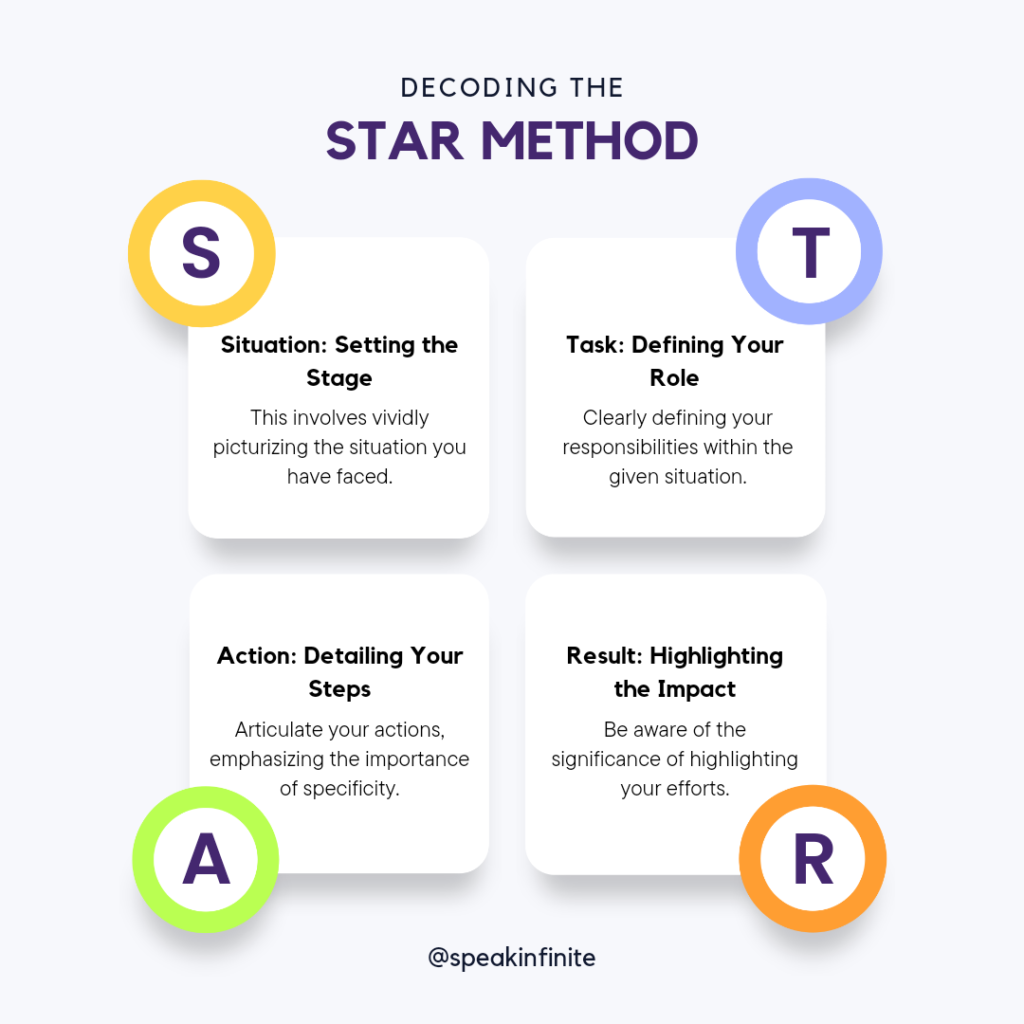Introduction:
The STAR method is a powerful tool for conquering the complexities of behavioral interview questions. Behavioral assessments are a crucial aspect of the interview in the evolving job market. This comprehensive guide delves into the concepts of the STAR method, providing an overview to help candidates navigate through these interviews with confidence and precision.
Unveiling the STAR method
Definition and Significance
The STAR method, which stands for Situation, Task, Action, and Result, is a structured technique formulated to facilitate articulating one’s past experiences. You can craft compelling narratives that showcase your skills, competencies, and problem-solving abilities by breaking down your responses into these four components.
Why STAR matters
Recognizing the significance of the STAR method is crucial for a candidate. It enables candidates to respond to behavioural questions in a systematic and organized manner. It allows interviewers to gain valuable insights into your thought processes, decision-making abilities, and the real-world impact of your actions.
Decoding the STAR method


Situation: Setting the stage
The first step in the STAR method involves vividly picturizing the situation you have faced. For example, imagine you were responsible for leading a team of members from different functional areas to implement a new software system within a tight deadline. The problem includes a complex project where multiple departments had to collaborate for seamless functioning. The challenge intensified due to the urgency and the need for precision. This brief scenario exemplifies the situation component of the STAR method.
Task: Defining your role
The focus is on clearly defining your role and responsibilities within the given situation. By understanding the task at hand, you set the stage for a comprehensive and impactful response.
Action: Detailing your steps
The heart of the STAR method lies in the actions you take to address the task. You must articulate your actions, emphasizing the importance of specificity and showcasing your problem-solving skills. For instance, if you were tasked with resolving a team conflict, your actions would include facilitating open communication, mediating discussions, and implementing a team-building workshop.
Result: Highlighting the impact
The ultimate goal of any action is the outcome. You must be aware of the significance of highlighting the consequences of your efforts and emphasizing the tangible impact on the situation, team, or organization.
Crafting stellar STAR responses
Practical Examples: Putting STAR into Action
From navigating challenging project deadlines to resolving team conflicts, these examples offer a blueprint for constructing your STAR responses. In this instance, detailing the situation, task, action, and result might involve:
- Describing a tight timeline.
- Your role as a leader.
- Implementing efficient project management (Action).
- Achieving a prosperous, on-time delivery (Result).
Do’s and don’ts of STAR responses
It is essential to avoid common pitfalls when using the STAR method, and practising how to do so can help make a lasting impression on your responses. Remember the dos and don’ts to succeed. For instance, a “do” could ensure your responses are concise and relevant, while a “don’t” may involve avoiding overly detailed responses.
Adapting STAR to diverse scenarios
Tailoring STAR for Leadership Scenarios
Behavioural questions often extend to leadership experiences. Adapt the STAR method to showcase your leadership skills effectively, providing concrete examples of successful leadership in action. For instance, if asked about leading a team through a crisis, articulate the situation, task, action, and result, mentioning how your leadership directed the team successfully.
Using STAR in Overcoming Challenges
Resolving challenges is a common theme in behavioural interviews. Emphasize applying the STAR method to narrate instances where you successfully navigated adversity, showcasing resilience and problem-solving abilities.
Advanced strategies for STAR success
STAR for Remote Work Contexts
In an era where remote work is gaining prominence, understanding how to apply the STAR method to virtual settings is essential. For instance, suppose you are asked about leading a remote team to achieve project goals. Use the STAR approach, detailing the situation (transition to remote work), task (leading a dispersed team), action (implementing virtual collaboration tools), and result (successful project completion).
Behavioural group interviews and STAR
Behavioural group interviews are a unique challenge. Explore advanced strategies for utilizing the STAR method in a group setting, ensuring you stand out.
Overcoming challenges in STAR responses
Addressing lack of experience
Individuals with minimal professional experience should focus on leveraging academic, volunteer, or personal experiences within the STAR framework. For example, if asked about a project during your studies, utilize STAR to articulate the situation, task, action, and result, emphasizing relevant skills gained.
Handling sensitive or confidential situations
When faced with questions about sensitive or confidential situations, learn how to navigate these queries within the ethical boundaries of the STAR method. For example, if asked about handling personal client information, structure your response using STAR to highlight the situation, task, action, and result, ensuring transparency and confidentiality.
Navigating questions about failure using STAR
Failure is a part of any professional journey. Candidates should focus on constructively addressing questions about failure using the STAR method, emphasizing lessons learned and improvements.
Interactive exercises to improve STAR skills
Mock Interview Scenarios
Engaging in practical mock interviews designed to simulate real-world behavioral questions helps you become familiar with the material and identify improvement areas. This hands-on approach allows you to refine your STAR responses and build confidence.
Self-evaluation and improvement strategies
Self-evaluation techniques allow you to identify areas for improvement in your STAR responses. For example, assess your STAR response for clarity and conciseness after a mock interview. Identify areas of improvement, such as providing more measurable results or enhancing the articulation of your actions, and incorporate these insights into your preparation for future interviews.
Conclusion: Mastering the art of STAR method
Mastering the STAR method is not just about memorizing a formula; it is an art. It is about presenting your experiences impactfully, leaving a lasting impression on interviewers. With a deep understanding of the STAR method, practical examples, and strategies for adaptation, you are now better equipped to conquer behavioural interview questions and pave your way to success in the competitive job market. Remember, each STAR response is an opportunity to showcase your unique value and stand out as the ideal candidate for the job.

